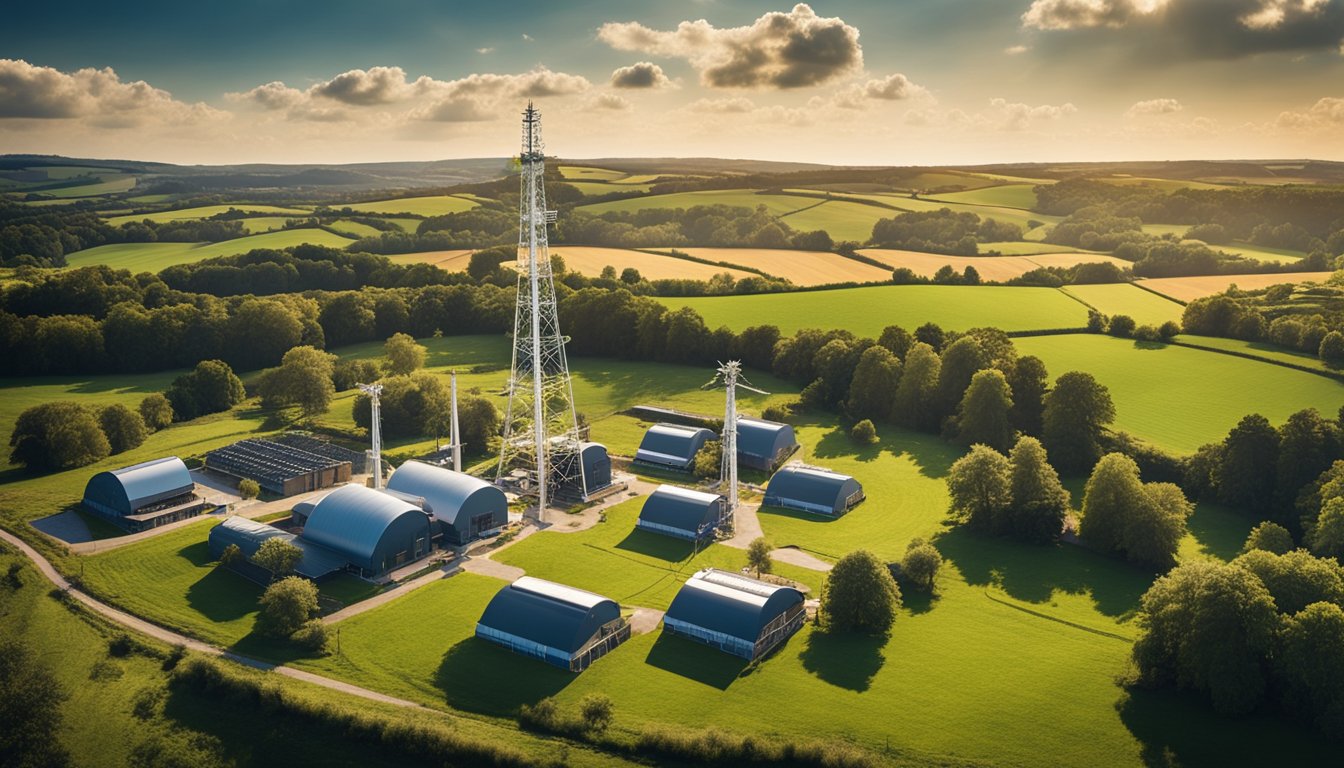Late updated: 08 Aug 2024 14:08
Written by: Oliver Bennett
Emerging Trends In UK Rural Digital Connectivity: Driving Future Growth
The transformative power of digital connectivity is making waves across the UK, especially in rural communities. As government initiatives push towards achieving 85% gigabit-capable broadband coverage by 2025, it is thrilling to witness the potential economic and social benefits unfold. Enhanced digital connectivity could inject a staggering £65 billion into the UK economy, highlighting the profound impact on rural areas.

Our exploration dives into the various aspects of this digital revolution, from the government's proactive steps to support rural broadband infrastructure to the emerging opportunities for rural businesses. With rural connectivity champions steering collaborations between the telecoms industry and local enterprises, the way we view rural development is being fundamentally altered.
We also keep an eye on the practical implications - how reliable high-speed connectivity enables rural communities to thrive in a digital economy. This includes addressing challenges like cyber vulnerabilities and bridging the rural-urban digital divide, allowing us to envision a future where every corner of the UK enjoys equal digital opportunities.
Key Takeaways
- Enhanced digital connectivity could boost the UK economy by £65 billion.
- Government targets 85% rural gigabit-capable broadband by 2025.
- Improved connectivity bridges the rural-urban digital divide, benefiting communities.
Digital Connectivity Landscape in UK Rural Areas
Rural digital connectivity is transforming the lives of residents and businesses in the UK. From broadband and 5G to satellite and wireless technologies, various initiatives are reshaping the digital landscape, driving productivity and accessibility.
Current State of Rural Connectivity
Rural areas in the UK have historically lagged behind urban centres in terms of digital infrastructure. As of now, over 75% of UK premises can access gigabit-capable broadband, a significant rise from just 6% a decade ago.
Despite these improvements, many remote areas still face digital exclusion. Many homes and businesses in regions like Ceredigion, Wales, are still struggling with slow and unreliable connectivity. This disparity impacts everything from education to healthcare and economic opportunities.
Government Initiatives
Several government initiatives target the improvement of rural digital connectivity. Project Gigabit is a £5 billion scheme aimed at delivering high-speed broadband to underserved areas.
The Shared Rural Network programme works to improve 4G coverage and eliminate mobile signal "not-spots" by 2025. The Levelling Up agenda also invests in digital infrastructure, aiming to ensure that rural areas benefit alongside urban counterparts.
Furthermore, the Rural England Prosperity Fund supports these efforts, providing funding to enhance digital infrastructure in rural communities.
Innovations and Technological Advancements
Technological advancements are pivotal in bridging the connectivity gap. 5G technology is being deployed in rural areas to offer faster speeds and improved reliability. Additionally, satellite and wireless technologies are expanding reach to places where traditional infrastructure is challenging to implement.
AI and drone technology are contributing to these efforts, facilitating real-time data collection and improving infrastructure maintenance. Innovations in clean heating upgrades and energy efficiency are also intertwined with digital connectivity, providing smart solutions to common rural challenges.
Challenges and Solutions
Despite progress, several challenges persist. High costs and logistical barriers often hinder the rollout of new technologies in remote areas. Affordable housing also remains an issue, affecting the overall effectiveness of connectivity improvements.
We must address these issues through collaboration between government bodies, private firms, and local communities. Subsidies and grants can mitigate costs for rural residents and businesses, ensuring that digital transformation is inclusive.
Further investment in emerging technologies and a focus on sustainable solutions will continue to drive progress, ensuring that rural areas are not left behind as the UK moves towards a digital-first approach.
Impact of Enhanced Connectivity on Rural Development

Enhanced rural connectivity holds transformative potential for various aspects of rural life, influencing economic growth, agricultural practices, and overall quality of life. Improved digital infrastructure allows for significant progress in these areas, benefiting both individuals and communities.
Economic and Social Effects
Enhanced connectivity facilitates economic growth by enabling rural businesses to operate more efficiently. Small enterprises and farmers can access broader markets, improving profitability. Job creation rises as digital businesses, e-commerce, and remote working become viable in rural areas.
Socially, connectivity fosters community engagement and access to essential services. Education and healthcare can be delivered digitally, breaking geographical barriers.
A £65 billion surge in the UK economy has been projected, demonstrating the economic potential. This boost stems from increased productivity and innovation in rural sectors.
Agriculture and Land Use
Digital connectivity transforms agriculture by introducing smart farming techniques. Farmers can utilise data-driven tools to monitor crops, manage livestock, and optimise resource use. This, in turn, enhances productivity and sustainability.
Advanced technologies support precise farming, leading to efficient land use. Wildlife conservation and sustainable practices benefit as farmers can balance productivity with environmental stewardship.
Increased access to real-time weather data and market analytics helps in making informed decisions, reducing risks related to crops and resource management.
Quality of Life Improvements
Enhanced connectivity leads to significant improvements in the quality of life for rural inhabitants. Mental health services and online education can be accessed from remote locations, improving well-being. Interactive experiences and digital participation in cultural activities become feasible, fostering a sense of community.
Tourism businesses in rural areas gain visibility and reach, attracting visitors and boosting local economies. Housing markets also benefit, as people are more willing to move to rural areas if reliable digital infrastructure is available.
Overall, enhanced connectivity equips rural areas with the tools needed to thrive in a digital age, making significant progress across multiple facets of rural life.
Frequently Asked Questions

Digital connectivity is rapidly transforming rural areas in the UK, empowering communities and driving significant economic growth. Several technological advancements, government initiatives, and persistent challenges shape this dynamic landscape.
What advancements are being made in technology to improve internet access in rural areas?
Significant investments in gigabit-capable broadband and the integration of satellite, wireless, and fixed-line technologies are key advancements. The introduction of the Rural Connectivity Accelerator pilot projects aims to address specific connectivity needs in remote regions.
How is internet connectivity contributing to the empowerment of rural regions?
Improved internet access enables remote work, access to digital services, and the growth of rural businesses. This connectivity fosters community engagement, enhances educational opportunities, and supports local healthcare services.
In what ways does the digital divide impact communities in the countryside?
The digital divide creates disparities in access to information, economic opportunities, and essential services. Rural communities often experience slower broadband speeds and limited technological infrastructure, hindering their ability to compete with urban areas.
What economic advantages does enhanced digital connectivity bring to rural economies?
Enhanced digital connectivity can boost the UK economy by as much as £65 billion. This growth stems from increased productivity, new business opportunities, and the ability to participate in the broader digital economy.
What challenges are being faced in delivering high-speed broadband to remote areas?
Infrastructure costs, geographic barriers, and limited population density pose significant challenges. Additionally, coordinating multiple technologies and securing consistent funding remain critical hurdles to achieving widespread high-speed broadband.
How are government initiatives shaping the future of rural digital infrastructure?
The government has launched various initiatives, including the Rural England Prosperity Fund and the appointment of a Rural Connectivity Champion. These efforts focus on innovative solutions and strategic investments to ensure sustainable digital growth in rural areas.
